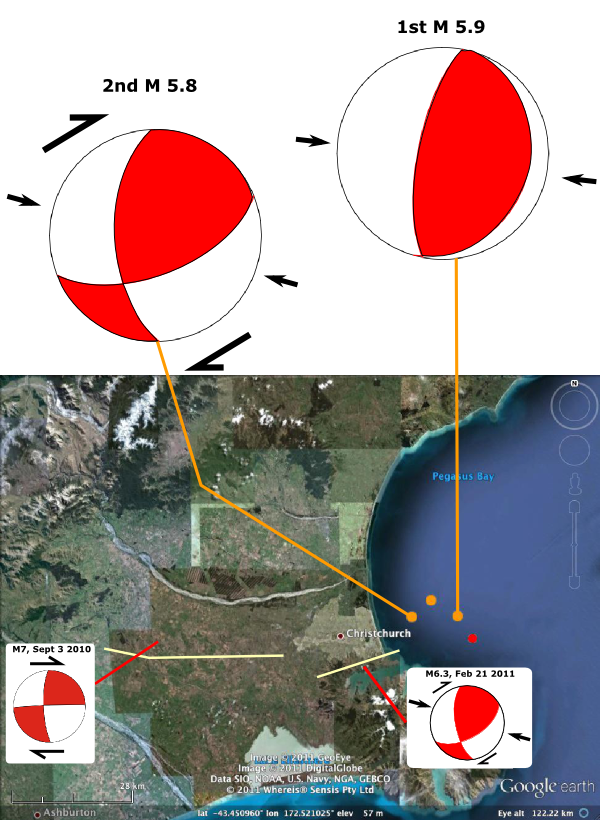![]() Just as it seemed that seismic activity was finally dying down in Christchurch, the city has been shaken by two more earthquakes. The USGS currently has the first shock pegged as a magnitude 5.8, and the second as a magnitude 5.9; the NZ Herald reports that the effects in Christchurch itself include loss of power, liquefaction and flooding, and rockfalls, but only minor injuries so far.
Just as it seemed that seismic activity was finally dying down in Christchurch, the city has been shaken by two more earthquakes. The USGS currently has the first shock pegged as a magnitude 5.8, and the second as a magnitude 5.9; the NZ Herald reports that the effects in Christchurch itself include loss of power, liquefaction and flooding, and rockfalls, but only minor injuries so far.
The first shock occurred about 2pm local time. The rupture was shallow (about 5 km deep) and located offshore, about 25 km miles east of Christchurch. The focal mechanism suggests westward thrusting on a north-south oriented fault. This earthquake was quickly followed by a magnitude 5.3 event. The second M 5.9 hit just under two-and-a-half hours later, 5 miles closer to the shore. It was also a relatively shallow rupture, and the focal mechanism also indicates thrusting, this time in a more northwest direction, mixed in with a bit of dextral strike-slip.

USGS focal mechanisms for the December 23rd M 5.8 earthquakes near Christchurch, with the focal mechanisms for the September 2010 Darfield and February 2011 Port Hills earthquakes, and their approximate ruptures, plotted for comparison.
(a primer on interpreting focal mechanisms)
It’s quite early, and the focal mechanism on the first shock in particular is a little poorly constrained by the look of things, but a few things stand out.
- The area that these earthquakes occurred in is along the trend of the fault – the Port Hills Fault, that ruptured in Feburary’s magnitude 6.3 earthquake. It’s likely that the Port Hills earthquake would have caused the stress in the crust in this region offshore to have increased slightly.
- Looking at the focal mechanism for February’s quake, it also indicates north-west directed thrusting with some dextral strike-slip.
- So whilst based on the first, less well-constrained, focal mechanism, I thought that this new sequence was due to motion on an entirely new fault, it is possible this is just stress being released on an eastward extension of the Port Hills fault that ruptured in February, or possibly a parallel strand of the same fault system.
It will probably become clearer as more data is collected and analysed in the next few hours and days. In the meantime, the NZ Herald has a rolling updates page on the situation in Christchurch. My guess would be that the smaller size of these earthquakes compared to the Darfield and Port Hills events, and the fact that they were further away than February’s shock, meant that the shaking from these earthquakes was much less likely to cause catastrophic damage on its own. However, the cumulative effect on already damaged buildings may be an issue, and liquefaction, and the flooding and subsidence that are associated with it, could greatly increase the long-term impact.



Comments (5)
Links (2)
-
-
Pingback: Relentless quakes in Christchurch « The Trembling Earth
Pingback: The latest events in the Christchurch earthquake sequence « Institute of Hazard, Risk and Resilience Blog